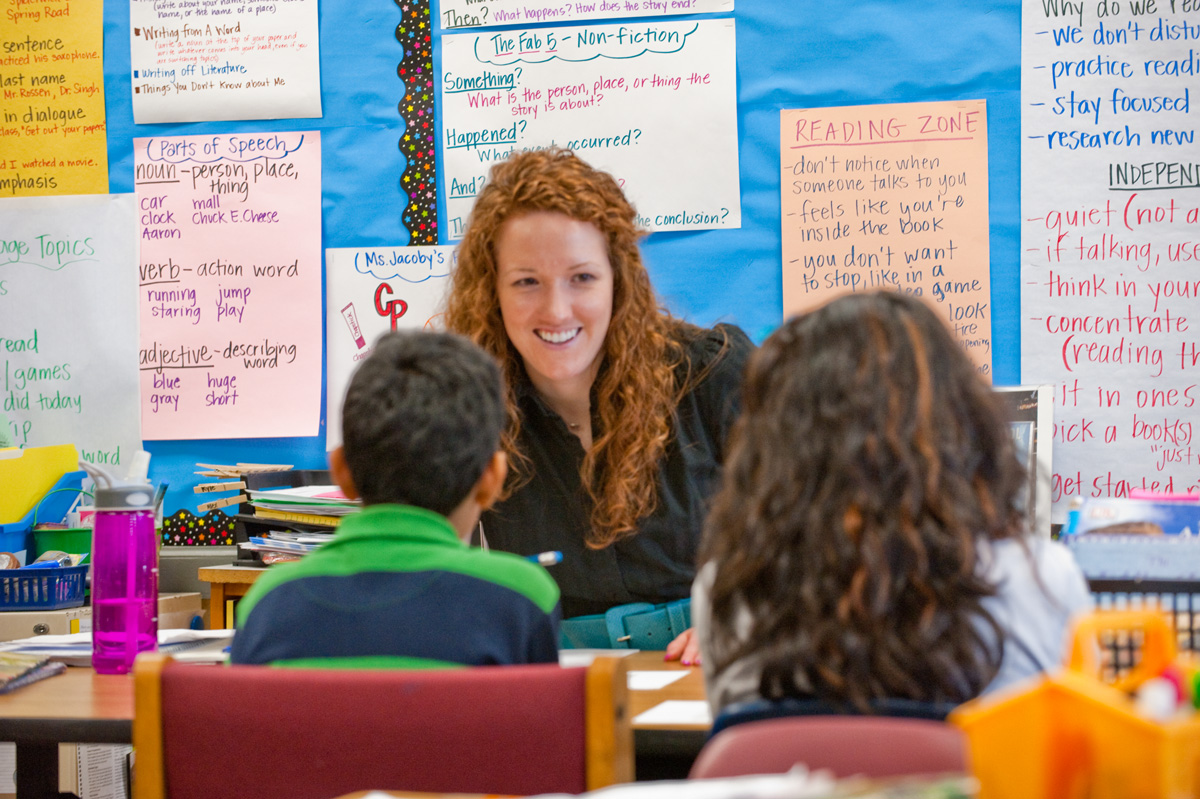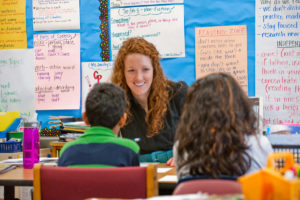A Conflict Resolution Protocol for Elementary Classrooms

 A basic belief underlying The Responsive Classroom approach to teaching is that how children learn to treat one another is as important as what they learn in reading, writing, and arithmetic. We believe that social skills such as cooperation, assertion, responsibility, empathy, and self-control are essential to children’s academic and social success and we emphasize the teaching of these skills, along with academics, throughout the school day.
A basic belief underlying The Responsive Classroom approach to teaching is that how children learn to treat one another is as important as what they learn in reading, writing, and arithmetic. We believe that social skills such as cooperation, assertion, responsibility, empathy, and self-control are essential to children’s academic and social success and we emphasize the teaching of these skills, along with academics, throughout the school day.
There are many strategies we use to teach these social skills at the elementary level (K–6), one of which is teaching a protocol for conflict resolution. Many good conflict resolution procedures have been developed and articulated in recent years (some excellent resources are cited at the end of this article). Below we outline one that has worked well in our classrooms.
The Steps
We usually introduce a conflict resolution protocol around the fourth or fifth week of school, once children are familiar with basic rules and routines and a sense of trust and community has been established in the classroom. As with most conflict resolution protocols, ours involves teaching children the following steps:
- Calming down (walk away, count to ten, etc.)
- Explanation of the upset
- Discussion and resolution
- Some kind of acknowledgment (handshake, for example)
The I-Statement
Before teaching these steps, however, we teach students to deliver emotion-laden information as I-statements, using the formula, “When you _________, I feel __________, because ________, so what I would like is ___________________.” When a child wants to meet with a classmate for conflict resolution, we require that she/he first compose an I-statement before arranging a time and a place for the meeting.
We display the I-statement formula and practice as a class, first, with positive, fun statements, such as “When you giggle, I feel happy, because it makes me giggle too, so what I would like is for you to keep on giggling.” Next, we practice with statements containing more difficult emotions, working with examples removed from direct personal experience. For example, we might use a situation from a book we are reading: “In Charlotte’s Web, when Wilbur heard he would get eaten, he felt scared, because he didn’t want to die, so what he would like is to be allowed to keep living.”
We also generate a list of words, from literature as well as from our own experience, to expand our vocabulary for describing feelings—words such as scared, sorry, sad, angry, frustrated, nervous, irritated. We display this list prominently in the room and children will often glance at it when composing I-statements.
The Meeting
In a conflict resolution meeting, the first child begins by making an I-statement, and the second child listens, then repeats back his/her understanding of what was said. Once the first child agrees that the second has heard correctly, the second child may make an I-statement. The routine continues in which one child makes an I-statement, then the other repeats back what she/he heard (a simple form of active listening), until both (or all) parties feel satisfied that an understanding has been reached and peace has been made.
In the early weeks, a teacher always attends conflict resolution meetings as a “fair witness” to ensure safety and protocol, but speaks as little as possible. As children become more adept with the process, the teacher asks if either one would like a teacher’s presence. If not, we leave them alone. We know that this approach to conflict resolution has become a part of our classroom culture when a student comes to a teacher and says, “Can we meet? I have an I-statement for you.”
The Strategy in Action
A solemn-looking Pearl approaches her fourth-grade teacher.
“I have an I-statement for Robby,” she says.
“Okay. Let’s hear it,” responds her teacher.
Pearl takes a deep breath. “Robby, when you said, ‘Pearly, Pearly, silly girly,’ I felt mad, because you were making fun of me, so what I would like is . . . so what I would like is . . .”
There is a pause while she looks up at the poster with our I-statement formula while she searches to define what she would like. “I would like for you to call me ‘Pearl,’ not ‘Pearly, silly girly.'”
“Sounds good,” says her teacher. “I will meet with you both after lunch.”
After lunch:
“Robby, Pearl has asked to meet with you,” his teacher informs him matter-of-factly. “Let’s go to the problem-solving table.” Robby looks apprehensive and grins sheepishly at his buddy Mike as he accompanies his teacher to the table where Pearl is already seated.
Robby takes a seat, shifting nervously and looking sideways at Pearl as he chews a fingernail. Pearl sits up straight, glances at the wall chart, and clears her throat. Even with rehearsal, to speak directly of upset is no easy feat. Out comes her I-statement, exactly as she had practiced.
As soon as she finishes speaking, Robby’s words start to tumble out. “Well, she was . . .”
His teacher interrupts. “Robby, you will have a chance for your own I-statement. Right now, it’s time to tell Pearl what you heard her say.”
“You don’t want me to say ‘Pearly, silly girly.'”
“Pearl, is that right?” asks their teacher.
“Yes.”
“OK, Robby. Would you like to make an I-statement or end with a handshake?” His choices are clear and defined.
“I want to make an I-statement,” asserts Robby. “Umm . . .” He glances at the chart for a cue.
“When you said my new backpack was ugly . . . I felt . . . annoyed because . . . I like my backpack, so I would like . . . for you not to say it’s ugly.”
Pearl needs no cue. “You don’t want me to say it’s ugly?”
“Yeah!” comes Robby’s emphatic response.
“Okay. I’m sorry.” There is silence while Robby digests this apology. (While often a child will apologize spontaneously during a conflict resolution meeting, we never require apologies as part of this process.)
“Robby,” asks his teacher quietly, “are you ready to shake hands or do you have another Istatement?”
The session closes with Robby and Pearl shaking hands (the handshake brings closure to the meeting, symbolizing that both parties have been heard and a mutual understanding has been reached).
Notice that Pearl’s teacher listens to Pearl’s I-statement before setting up the meeting. It is important for the teacher to have a preview of the issue and to make sure that the student has a legitimate I-statement. It is also important for the student to have practice saying it aloud. Though it may seem a simple and formulaic process, it takes great courage for students to initiate it and carry it through, and, in the meeting itself, it helps to have the starting words ready. Notice, too, how many times Pearl and Robby both look to the chart for prompts. This happens not just in the beginning of the year but all year long. It’s important to keep the chart clearly visible from the problem solving spot.
Over and over again, we find that having a ritualized procedure for solving problems can help even the youngest elementary school children resolve conflict peacefully with a minimum of adult intervention. The communication and social skills developed in the process empower students to assert their feelings and experiences while maintaining respect for the feelings and experiences of others.
Additional Resources for Teaching Conflict Resolution
in Elementary Schools:
- Porro, B. (1996). Talk it out: Conflict resolution in the elementary classroom. Alexandria, Va.: Association for Supervision and Curriculum Development.
- Prutzman, P., Burger, G. Bodenhamer, and L. Stern. (1988). The friendly classroom for a small planet. Philadelphia, Pa.: New Society Publishers.
- Kreidler, W.J. (1990). Elementary perspectives: Teaching concepts of peace and conflict. Cambridge, Mass.: Educators for Social Responsibility.
- Levin, D.E. (1994). Teaching young children in violent times: Building a peaceable classroom. Cambridge, Mass.: Educators for Social Responsibility.
- Resolving Conflict Creatively Program (RCCP): A comprehensive school-based program in conflict resolution and intergroup relations that provides a model for preventing violence and creating caring and peaceable communities of learning.
This article is an adapted excerpt from the book, The First Six Weeks of School.
Tags: Apologies, Conversation Skills, Misbehavior